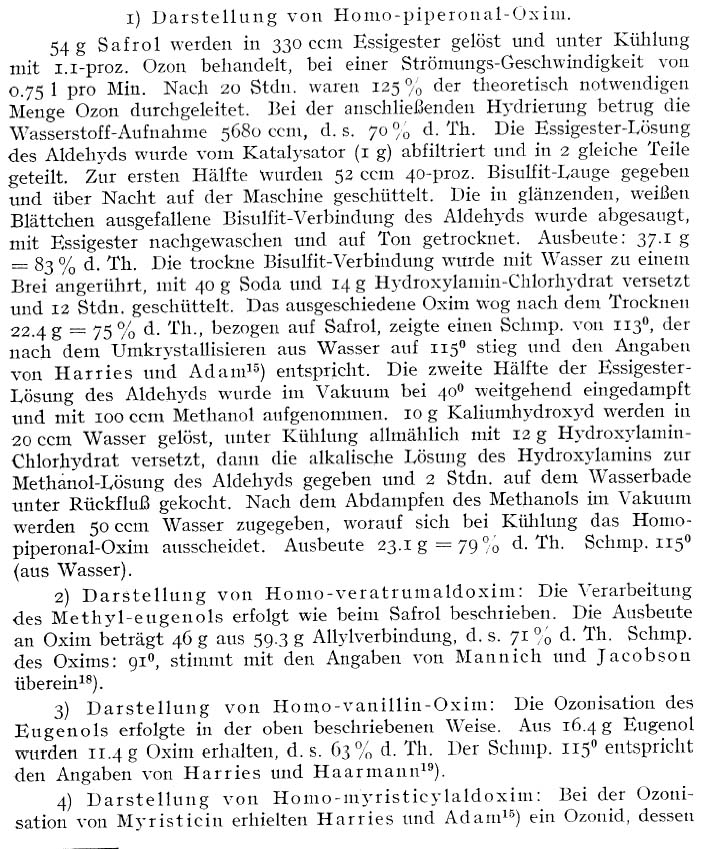enima
Hazard to Self
 
Posts: 98
Registered: 1-12-2004
Member Is Offline
Mood: No Mood
|
|
From Allybenzenes to Oximes. (Need translation
Found this paper that some might find useful,
the paper uses safrole and converts to the a homo-piperanol oxime.
It could possibly be used for other allybenzene compounds as well.
From from what I understand the allybenzene is placed in ethyl acetate, ozone is pumped thru the solution at 0.75 liter per minute.
Next part I understand the phenylacetylaldehyde is converted to the oxime with NaOH and hydroxylamine.hcl ....
can anyone help translate this?
[Edited on 18-2-2005 by enima]
|
|
|
enima
Hazard to Self
 
Posts: 98
Registered: 1-12-2004
Member Is Offline
Mood: No Mood
|
|
Attachment

|
|
|
chemoleo
Biochemicus Energeticus
    
Posts: 3005
Registered: 23-7-2003
Location: England Germany
Member Is Offline
Mood: crystalline
|
|
How feasible is an oxidation with ozone? Is anyone actually going to bother doing this before I translate this? 
Never Stop to Begin, and Never Begin to Stop...
Tolerance is good. But not with the intolerant! (Wilhelm Busch)
|
|
|
enima
Hazard to Self
 
Posts: 98
Registered: 1-12-2004
Member Is Offline
Mood: No Mood
|
|
If I can get a hold of an ozone generator, I'll try it.
|
|
|
trilobite
Hazard to Others
  
Posts: 152
Registered: 25-2-2004
Location: The Palaeozoic Ocean
Member Is Offline
Mood: lonely
|
|
This is a reaction you can find even in the elementary textbooks, so it works, even on industrial scale to my knowledge. Oxidation of a double bond to
a molozide intermediate which then rearranges very rapidly to an ozonide, which is then reduced (with catalytic hydrogenation in that article by the
way, zinc in AcOH works also) to two aldehydes, allylbenzenes giving phenylacetaldehydes and formaldehyde, 1-propenylbenzenes giving benzaldehydes and
acetaldehyde.
R1-C=C-R2 ---> R1-CO + OC-R2
Safrole gives 3,4-methylenedioxyphenylacetaldehyde aka homopiperonal, isosafrole 3,4-methylenedioxybenzaldehyde aka piperonal.
But I want to ask: are you sure you know what you are aiming at with this reaction? The oxime gives 3,4-methylenedioxyphenethylamine aka MDPEA on
reduction, one carbon less than most prefer that is. There has been a lot of discussion about the method in the past online mostly relating to
preparation of piperonal but very little experimental beework.
|
|
|
enima
Hazard to Self
 
Posts: 98
Registered: 1-12-2004
Member Is Offline
Mood: No Mood
|
|
well, I'm trying to get the general proceedure down, there is a plant which contains elemicin @ 80% levels in the essential oil, (a tea tree
speicies). It would be faily easy to yield mescaline, or synthesis of 2,5-dimethoxyallybenzene from methoxyphenol would yield 2c-h. I guess even the
methylation could be done with something harmless like betaine.
But my interest in this proceedure isn't for the end product, I'm more interested in the ability to perform the proceedure.
[Edited on 18-2-2005 by enima]
|
|
|
joe_aldehyde
Hazard to Self
 
Posts: 68
Registered: 26-3-2005
Member Is Offline
Mood: what is mood?
|
|
i can translate, no prob, if you name me the tea tree species along with sources 
|
|
|
Vogelzang
Banned
Posts: 662
Registered: 26-4-2008
Member Is Offline
Mood: No Mood
|
|
Melaleuca squamophloia
I) Production of Homo-piperonal-Oxime
54 g Safrol was dissolved in 330 cc of acetic ester under cooling with treatment with 1.1 % ozone at a current velocity of 0.75 l/min. After 20 hours
125% of the theoretically necessary amount of ozone was lead through. Following with hydrogenation showed a hydrogen take-up of 5680 cc - 70%
theoretical. The acetic ester solution of the aldehyde was from the catalyzer (1g) filtered out and divided into two equal parts. To the first part
52 cc 40% of caustic bisulfite (sodium bisulfite?) was added and over night shaken on the machine. Glossy white platelets precipitated out, the
bisulfite addition compound was filtered with suction, washed with acetic ester and dried on ceramic. Yield: 37.1 g = 83% Theory. The dried bisuflite
compound was mixed with water to a paste, 40 g soda and 14 g hydroxylamine hydrochloride were added and shaken 12 hours. The separated out oxime
weighed after drying 22.4 g = 75% Theory, with respect to safrole, showed a melting point of 113 degrees, this after recrystallization from water rose
to 115 degrees and agreed with the results of Harries and Adam 15) . The two halves of acetic ester solutions of the aldehydes were evaporated to a
large extent and taken up with methanol. 10 g. KOH was dissolved in 20 cc water, under cooling 12 g hydroxylamine hydrochloride was gradually added,
then the alkaline solution of hydroxylamine added to the methanol solution of the aldehyde and heated on a water bath for 2 hours under reflux. After
evaporation of the methanol in vacuum and addition of 50 cc water, with cooling the homo-piperonal-oxime separated out. Yield 23.1 g = 79% theory,
melting point 115 degress (from water).
2) Production of homo-veratrumaldoxime: Working with methyl-eugenol follows as with safrole as described. The yield of oxime was 46 g from 59.3 g
allyl compound, 71 % theory, melting point of the oxime: 91 degrees, in agreement with the results of Mannich and Jacobson 18).
3) Production of homo-vanillin-oxime: Ozonisation of eugenol follows as in the above described way. From 16.4 g eugenol 11.4 g oxime was obtained, 63%
theory. The melting point 115 degrees agrees with the work of Harries and Haarmann 19).
4) Production of Homo-myristicylaldoxime: By ozonisation of myristicin Harries and Adam 15) obtained an ozonide, this...
[Edited on 21-6-2011 by Vogelzang]
|
|
|
Vogelzang
Banned
Posts: 662
Registered: 26-4-2008
Member Is Offline
Mood: No Mood
|
|
O3 references
http://www.4shared.com/folder/8bTQVaki/O3_online.html
|
|
|